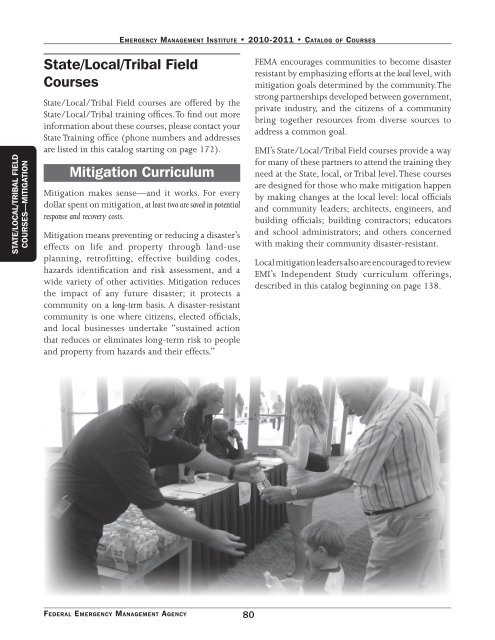enrollment for emi courses - Emergency Management Institute ...
enrollment for emi courses - Emergency Management Institute ...
enrollment for emi courses - Emergency Management Institute ...
You also want an ePaper? Increase the reach of your titles
YUMPU automatically turns print PDFs into web optimized ePapers that Google loves.
statE/lOcal/trIbal fIElD<br />
cOursEs—mItIgatIOn<br />
EmE r g E n c y ma n a g E m E n t In s t I t u t E • 2010-2011 • ca t a l o g of co u r s E s<br />
state/local/tribal field<br />
<strong>courses</strong><br />
State/Local/Tribal Field <strong>courses</strong> are offered by the<br />
State/Local/Tribal training offices. To find out more<br />
in<strong>for</strong>mation about these <strong>courses</strong>, please contact your<br />
State Training office (phone numbers and addresses<br />
are listed in this catalog starting on page 172).<br />
mitigation curriculum<br />
Mitigation makes sense—and it works. For every<br />
dollar spent on mitigation, at least two are saved in potential<br />
response and recovery costs.<br />
Mitigation means preventing or reducing a disaster’s<br />
effects on life and property through land-use<br />
planning, retrofitting, effective building codes,<br />
hazards identification and risk assessment, and a<br />
wide variety of other activities. Mitigation reduces<br />
the impact of any future disaster; it protects a<br />
community on a long-term basis. A disaster-resistant<br />
community is one where citizens, elected officials,<br />
and local businesses undertake “sustained action<br />
that reduces or eliminates long-term risk to people<br />
and property from hazards and their effects.”<br />
FEd E r A L Em E r g E N C y mA N A g E m E N T Ag E N C y 80<br />
FEMA encourages communities to become disaster<br />
resistant by emphasizing ef<strong>for</strong>ts at the local level, with<br />
mitigation goals determined by the community. The<br />
strong partnerships developed between government,<br />
private industry, and the citizens of a community<br />
bring together resources from diverse sources to<br />
address a common goal.<br />
EMI’s State/Local/Tribal Field <strong>courses</strong> provide a way<br />
<strong>for</strong> many of these partners to attend the training they<br />
need at the State, local, or Tribal level. These <strong>courses</strong><br />
are designed <strong>for</strong> those who make mitigation happen<br />
by making changes at the local level: local officials<br />
and community leaders; architects, engineers, and<br />
building officials; building contractors; educators<br />
and school administrators; and others concerned<br />
with making their community disaster-resistant.<br />
Local mitigation leaders also are encouraged to review<br />
EMI’s Independent Study curriculum offerings,<br />
described in this catalog beginning on page 138.

















